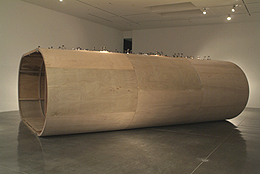
Steve Roden, (ear)th, 2004
ear(th)
An installation by Steve Roden
with AnnMarie Polsenberg Thomas
in collaboration with Mark Simons
October 9 - December 22, 2004
ear(th) was a collaboration between Steve Roden and Caltech robotics graduate student AnnMarie Polsenberg Thomas, with geophysicist Mark Simons. ear(th)utilized data captured by Simons' satellite observations of earth's tectonic stresses, and converted them into sound — symbolizing a musical score written by earth forces. The sound-making devices in the sculpture were tiny servo motors that pound xylophone bars, and were designed and programmed by Polsenberg Thomas.
The scientific data for ear(th) came from an Interferometric Synthetic Aperture Radar (InSAR) image, or interferogram, of the 1999 Hector Mine earthquake in California. Interferograms typically extend hundreds of kilometers with a resolution of twenty meters/pixel and have an ability to detect movements of the Earth as small as a few millimeters. Roden used this interferometric data as a set of instructions to tell eighty small robots to strike glockenspiel, or xylophone, bars of different pitches. His installation used stresses and strains on the earth's crust as a model for the sequence of pitches, and the placement of those pitches within an architectural/sculptural space; allowing the earth, through its suggestions of the spatial and musical order of sound, to become the composer and conductor of a piece of music.
more images...
ear(th) was part of The Tender Land festival.